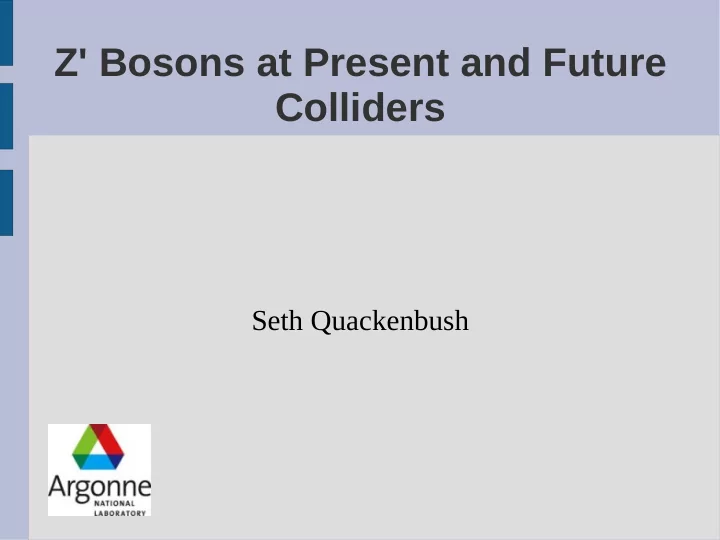

Z' Bosons at Present and Future Colliders Seth Quackenbush
Outline ● Models upon models ● Z' goals ● Old colliders ● LHC ● New colliders – ILC – CLIC/muon collider
The nature of a Z' ● Many extensions to Standard Model predict a new neutral resonance ● Let's call a Z' spin 1 (usual definition) ● Can narrow properties of Z' Lagrangian using phenomenological arguments: – Fermion left-handed doublets should couple the same (would imply/induce Z-Z' mixing) – Fermion generation independence (would induce FCNC)
Models upon models ● Two broad categories of models: – ”Usual models” fit above constraints ● (Effective) rank-5 GUTS: – E 6 (ψ, η) – SO(10) (χ, LR, ALR) ● Any other consistent set of couplings you want to write down – ”Unusual models” evade above constraints ● Little Higgs (extra quantum numbers protect mixing) ● KK modes (same) ● Light/heavy (3 rd generation not constrained) ● Technirho (?) ● ???
What to do with so many models ● Finding a resonance is the easy part – ”If you can't find a Z' at the LHC, you should turn it off.” ● Can't check every model against data ● Some models have free parameters (e.g., E 6 ) ● More model-independent approach needed ● Find Z' couplings to fermions (others?)
Constraints on Z' ● LEP rules out most Z' models to ~1 TeV by indirect search (dileptons) ● Tevatron rules out most Z' models to ~800 GeV by direct search (dijets) ● Low energy experiments (e.g., E-158) rule out most Z' models to ~1 TeV by dim-6 operators ● Get around these searches with, e.g., very small couplings
Z' Possibilites ● Group Z' possibilities at future colliders into mass categories: – Light: 1 TeV < M Z' < 2 TeV – Medium: 2 TeV < M Z' < 6 TeV – Heavy: 6 TeV < M Z' < 15 TeV – Other: very unusual scenarios/models
Z' at the LHC ● Z' must be made from quarks here ● QCD buries decays into quarks (tough possibility to see decays into b/t) ● Cleanest signal is dileptons – Discover up to ~6 TeV – Clean enough to do physics! – Get mass (ΔM ~ 0.1% M) – De-convolute B-W shape (ΔΓ ~ 0.1% M) – Begin extracting coupling parameters
Medium Z' at the LHC ● Only on-peak measurements useful – F/B, rapidity distributions ● c q = (q L 2 +q R 2 )(e L 2 +e R 2 )/24πΓ 2 -q R 2 )(e L 2 -e R 2 )/24πΓ e q = (q L ● No sign determination! Petriello, SQ ● Enough to differentiate/rule out typical models
Light Z' at the LHC ● On + off-peak measurements give signs ● Get width ΔΓ ~ 1 GeV ● Some directions in parameter space Li, Petriello, SQ determined much better than others ● More than enough to rule out other models ● q X e degeneracy
LHC Drawbacks ● Rapidity/F-B asymmetry measurements sufficient to determine couplings only for 4 free coupling parameters, ”usual” models (u L =d L ) – Test other models individually ● Degeneracy in coupling space (can trade q for e) unless lucky in heavy quarks ● Limited precision, poorly measured directions
Lepton colliders ● Deviations in dilepton observables off-peak sufficient to discover Z' up to ~6X c.o.m. energy – ILC: discover light, medium Z' if not found at LHC (small coupling to quarks) – CLIC/muon collider: discover heavy Z' far past LHC mass range ● If mass known, measure couplings off-peak – leptons→leptons + leptons→quarks gives all combinations, no degeneracy, better precision than LHC
Lepton colliders (cont'd) ● To determine individual couplings, need the following: – Some way to separate left, right-handed couplings (Forward/backward asymmetry, polarization asymmetry) – Differentiation of different final state particles (tags on heavy quarks)
ILC ● Discover Z' if weakly coupled to quarks ● Leptonic couplings well- determined for light Z' ● Quark coupling extraction depends on lepton Riemann extraction, b tagging, c (!) tagging ● In principle can get mass, couplings if not found at LHC (hard) Rizzo
CLIC/Muon collider ● Scale ILC results with energy ● Light Z': Z' factory? ● Polarization assumed in previous studies, but redundant to angular information – Cross check; sort out KK Z', γ'? Rizzo – Is polarization necessary for good results? Is it worth a cut in luminosity? Is ”natural” polarization sufficient?
CLIC vs. Muon collider ● CLIC ● Muon collider – At least electrons – Probably automatic polarized to 80% 20% polarization – Heavy quark tagging – Better energy probably easier resolution ● Trace of BW shape – More detector ● More Z' if width very coverage (easier to narrow ID top decays) – Less ISR – More ISR (easy – What if Z' doesn't radiative return to couple to electrons? peak) Freitas
The case for polarization ● Off peak, too few P = 0 P = 0.2 events for good F/B P = 0.8, 150 fb -1 separation P = 0.8 ● Polarization much more efficient at separating L/R couplings s = (3 TeV) 2 M = 5 TeV 300 fb -1 68% CL
What about cone angle? ● Angular distribution only handle on quark couplings, leptons if no polarization ● Size of cone doesn't seem to matter 20 degrees 6 degrees
Z' Outlook ● A Z' is only interesting if we find out what it is ● LHC can certainly narrow it down, but still missing information ● Future letpon colliders should be able to measure more parameters, and better ● What kind of collider we need will depend on Z' mass ● More study needed on polarization, heavy quark (incl. top) ID
Bonus Material
Recommend
More recommend